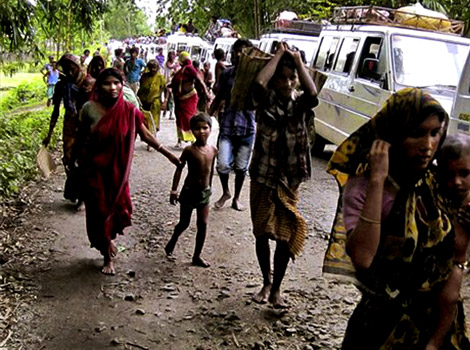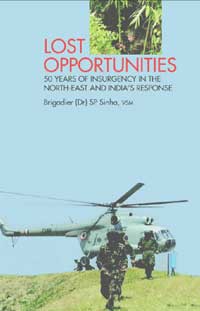A small group had escaped arrest and continued to stay in East Pakistan. Their leader, Sudhir, who by then had formed RGM, succeeded in getting Pakistani support and received guerilla training during the period 1970-71. They put their training to practice during the 1971 Indo-Pak war, engaging Indian security forces, particularly the police and paramilitary forces, in ambushes and raids on isolated police posts close to the border. But the outcome of the war forced them to return to Manipur. Some died in engagements while crossing the border, but three of them successfully slipped into Manipur, where they were finally apprehended at Nungba in Tamelgong District.21
China’s Support to Meitei Insurgents
The Chinese trained Meitei insurgents not in Yunan but in Lhasa. The Meiteis under the charismatic Bisheshwar took an unconventional route via Kathmandu to reach Lhasa. They were ideologically left oriented and differed from Nagas whose ideological moorings were not very strong. The Meiteis were the ones to introduce urban guerilla warfare techniques and engage Indian troops in built up areas in the Imphal Valley.
Pakistan’s and Bangladesh Support to Insurgents of Tripura
The seeds of insurgency were sown in Tripura soon after the Mizos had risen in revolt. But the defeat of the Pakistani Army in 1971 and the emergence of Bangladesh had changed the geo-political scene. There was a lull in insurgent activities for a while, but not for long. The Mizos began returning from their base in Arakan to Bangladesh in October 1976. MNF established its tactical headquarters in the Sajek ranges in CHT at a place called Langkor. Their headquarters was moved near the Tri Junction of Mizoram-Arakan-CHT to a place called Chhintalang in Bangladesh.
The Meiteis were the ones to introduce urban guerilla warfare techniques and engage Indian troops in built up areas in the Imphal Valley.
Sometime in 1977, Hrangkhwl sent two emissaries to Chittagong with a letter for Bangladesh President, Zia-ur-Rehman. The two emissaries were intercepted by Bangladesh Police, interrogated and sent back to Tripura, but it appears, Hrangkhwl’s letter reached the president. The Bangladesh intelligence agreed to help TNV, but only through the MNF. The first group of TNV volunteers led by Chuni Koloi trekked to Chhintalang in the beginning of 1979, stayed with the MNF and took part in attacks on security forces jointly with them. The subsequent groups were given basic training and returned to Tripura. By the end of 1979, TNV had set up a camp in the jungles of CHT. After the ethnic violence that had erupted in Tripura in mid 1980, many young tribals took refuge in the jungles of CHT. The riots gave a boost to insurgency in Tripura. According to one estimate the MNF trained nearly 130 tribals between September and November 1980.22
After the disbandment of TNV in December 1980, All Tripura People’s Liberation Organisation (ATPLO) was formed, but it was not supported either by Bangladesh or Pakistan. ATPLO received support mainly from the MNF, which trained nearly 100 of its volunteers. Chuni Koloi who was heading the ATPLO, made several attempts to contact Bangladesh officials between 1980 and 1982 but failed.
After the revival of TNV in November 1982, the links between TNV and MNF were revived. 60 TNV volunteers were trained by MNF in early 1983.23 Hrangkhwl again tried to seek support from Bangladesh. Ananta Debbarma, TNV home secretary, met a Bangladeshi official at Mariswa, which was an important listening past for Bangladesh on the border with Tripura. In May 1983, Hrangkhwl himself contacted a senior Bangladeshi army official at Chittagong, who promised to give some ammunition but no weapons. Hrangkhwl made a secret trip to Pakistan in April 1985 with two ISI officials, who promised to help through Bangladesh, but the news leaked out. Bangladesh developed cold feet apprehending India might intensify support to Shanti Bahini guerillas.24 The promised support to TNV did not materialise.
Insurgency in Tripura declined after the Mizos signed an accord with the Indian Government in 1985. This forced Hrangkhwl to negotiate with the government but even after signing the accord in 1988, the remnants of TNV have continued to operate from bases in Bangladesh. Ashok Tandon, Director General of Border Security Force (BSF), in his annual conference on November 27, 1997 admitted that both ATFF and NLFT continue to get support from Bangladesh. In spite of Indian protests, Bangladesh failed to close down rebel camps in its territory.25
Pakistani and Bangladeshi Support to ULFA
The credit for forging ULFA’s connection with Pakistan’s ISI goes to one Munim Nobis, who belonged to Guwahati. Before joining ULFA, Nobis was a member of Assam People Liberation Army (APLA), which was formed at Tezpur at the same time as ULFA. By 1983, APLA had formed a wide network of activists in Mangaldoi, Barpeta and Nagaon. Many APLA members were arrested and this forced it to merge with ULFA.
The first unsuccessful attempt by Nobis to contact ISI was made in 1988. He traveled to Karachi in the company of a Bangladeshi businessman who was well connected with both Bangladeshi and Pakistani intelligence operatives, but the businessman failed to put Nobis in contact with any important ISI functionary in Karachi. Nobis made the next attempt the following year but was told to come again with a more representative team. Senior ULFA leaders 26 flew to Karachi sometime in 1990 from where they were taken to Islamabad and then to Peshawar, which at that time was the headquarters of several Afghan mujahideen groups. The team was given intensive training in strategy, tactics, counter-intelligence, disinformation and use of weapons. The training lasted for one month after which they returned to Assam. No weapons were given at this stage.The next visit of ULFA leaders comprising of Paresh Barua, the commander of the military wing and Sunil Nath, the publicity secretary took place in September 1991. They were taken to Darrah in North West Frontier Province that is one of the world’s biggest open but illegal arms bazaar. The Pakistanis wanted ULFA to attack high priority strategic targets like oilfields and government buildings. ULFA rejected the suggestion fearing that it would turn the public against them.
The Pakistanis also cautioned ULFA leaders not to confront the Indian Army directly. But ULFA had other ideas; it was confident of taking on the Indian Army head-on but rejected the suggestion to destroy economic assets, which would only alienate them from the general public.27 ULFA, however, changed its tactics after Operations Bajrang and Rhino when they found the army too strong for them. Ironically, they subsequently began to target economic assets like oilfields and pipelines, which they had wisely spared fearing adverse public reaction.
In March 1994, the Assam Assembly was informed that ULFA militants had received training with the help of Pakistan’s ISI, most of them in Afghanistan. ULFA also established contact with Bangladesh Field Intelligence unit in Dhaka and was allowed to establish training camps in Bangladesh in Mymensingh district at Bhemugach, Nilfarman and Dhami, all in Maulvi Bazaar area.28 However, after the victory of the Awami League under Sheikh Hasina in the 1995 elections, the Government of Bangladesh decided to freeze all help to the North-east insurgents.
Sanctuaries in Myanmar and Bhutan
Following the crackdown by Bangladesh during the regime of Sheikh Hasina, many ULFA camps shifted from Bangladesh to Manas Reserved Forests in Assam and in the forests of South Bhutan close to the Indo-Bhutan border, from where they were physically removed in a military operation by the RBA in December 2003.
Appraisal
The support given by China and Pakistan to North-east insurgents was a consequence of antagonistic relations with China and Pakistan. Unlike East Pakistan and Bangladesh, the sanctuaries of North-east insurgents in Myanmar are not the result of adversarial bilateral relations between the two countries, but due to the inability of the Myanmar Government to effectively administer their hilly areas along India’s border.29 The abetment of insurgency in Tripura was partially quid-pro-quo for the support India was extending to Chakma insurgents the Shanti Bahini.
In the case of sanctuaries in Bhutan, the king tried to get the ULFA camps vacated from Bhutanese territory through talks, but when ULFA refused to vacate the camps even after an ultimatum, the RBA in a swift and well-planned operation in December 2003 destroyed the camps and forced them to flee. The action taken by Bhutan should be taken as an example of cooperative approach to effectively fight insurgencies in South Asia.
Notes and References
- VIK Sareen, India’s North-east in Flames, (New Delhi: Vikas Publishing House, 1980), p. 145.
- Urmila Phadnis, Ethnicity and Nation Building in South Asia, (New Delhi: Sage Publications, 1990), p. 150.
- Urmila Phadnis, n.2., p. 235. Also VIK Sareen, n. 1., pp. 24-27. Sareen gives a lucid account of CIA’s activities in the North-east in early 1970s.
- Prakash Singh, Nagaland, (New Delhi: National Book Trust, 1972), p. 122. Prakash Singh was then posted in the Intelligence Bureau in Nagaland.
- Ibid.
- Ibid., p. 124.
- Ibid., p. 123.
- RD Palsokar, Forever in Operations: History of 8 Mountain Division, 1992, pp. 63-64. and Prakash Singh, n. 4.,, pp. 131-132. The army raided Jatsoma camp in June 1968. 25 hostiles with Chinese arms and ammunition were captured. The underground Nagas had clearly violated the agreement on cessation of hostilities. BK Nehru, who had become the Governor of Nagaland in April 1968, forced the Nagas to adhere to the agreement on suspension of hostilities.
- The Hindustan Times, New Delhi, July 18, 1968. Quoted by Prakash Singh, n.4., p.136.
- Statement made by the Defence Minister in the Lok Sabha on December 3, 1969.
- Prakash Singh, n. 4., p. 138.
- Col Palsokar has vividly described the conduct of the whole operation. See RD Palsokar, n. 8., Ch 10, pp.136-157.
- Asoso Yonuo, The Rising Nagas, (New Delhi: Vikas Publishing House, 1974), p. 305.
- Subir Bhaumik, Insurgent Crossfire: North-east India, (New Delhi: Lancers, 1996), p. 171.
- Ibid., p. 172.
- Times of India, New Delhi, October 1, 1984. Quoted by Urmila Phadnis, p. 235.
- Subir Bhaumik, n. 14., p. 166.
- Ibid., pp. 173,176,177.
- Sylhet has a large Meitei community, which had migrated from Manipur to escape from the Burmese attack in the early twentieth century.
- For a more comprehensive account see Phanjoubam Tarapot, Insurgency Movement in North-east India, (New Delhi: Vikas Publishers), pp. 42-46.
- Ibid., p. 46.
- Subir Bhaumik, n. 14., p. 214.
- Ibid., p. 222.
- “Pak-TNV links Established,” The Telegraph, Calcutta, October 1, 1985. Quoted by Subir Bhaumik, n. 14, p. 230.
- The Hindustan Times, New Delhi, November 29, 1997.
- Rajkhowa, ULFA president, Hirakjyoti Mahanta, the deputy commander of military wing, Predeep Gogoi, the vice president, Anup Chetia, the general secretary and Manoj Hazarika. For a fuller account of how ULFA made contact with ISI see Sanjoy Hazarika, Strangers of the Mist: Tales of War and Peace from North-east, (New Delhi: Penguin, 1995), pp. 170-175.
- Ibid., p. 174.
- Ibid., p. 235.
- For a scholarly analysis of external factors in the spread of insurgency see Urmila Phadnis; Ethnicity and Nation Building in South Asia, (New Delhi: Sage Publications, 1989).






